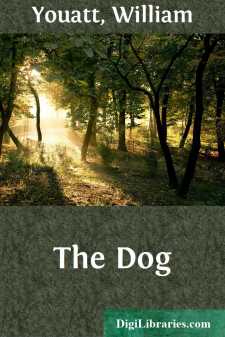Categories
- Antiques & Collectibles 13
- Architecture 36
- Art 48
- Bibles 22
- Biography & Autobiography 813
- Body, Mind & Spirit 142
- Business & Economics 28
- Children's Books 17
- Children's Fiction 14
- Computers 4
- Cooking 94
- Crafts & Hobbies 4
- Drama 346
- Education 46
- Family & Relationships 57
- Fiction 11829
- Games 19
- Gardening 17
- Health & Fitness 34
- History 1377
- House & Home 1
- Humor 147
- Juvenile Fiction 1873
- Juvenile Nonfiction 202
- Language Arts & Disciplines 88
- Law 16
- Literary Collections 686
- Literary Criticism 179
- Mathematics 13
- Medical 41
- Music 40
- Nature 179
- Non-Classifiable 1768
- Performing Arts 7
- Periodicals 1453
- Philosophy 64
- Photography 2
- Poetry 896
- Political Science 203
- Psychology 42
- Reference 154
- Religion 513
- Science 126
- Self-Help 84
- Social Science 81
- Sports & Recreation 34
- Study Aids 3
- Technology & Engineering 59
- Transportation 23
- Travel 463
- True Crime 29
The Dog
by: William Youatt
Description:
Excerpt
CHAPTER I.
THE EARLY HISTORY AND ZOOLOGICAL CLASSIFICATION OF THE DOG.
The Dog, next to the human being, ranks highest in the scale of intelligence, and was evidently designed to be the companion and the friend of man. We exact the services of other animals, and, the task being performed, we dismiss them to their accustomed food and rest; but several of the varieties of the dog follow us to our home; they are connected with many of our pleasures and wants, and guard our sleeping hours.
The first animal of the domestication of which we have any account, was the sheep. "Abel was a keeper of sheep." [1] It is difficult to believe that any long time would pass before the dog—who now, in every country of the world, is the companion of the shepherd, and the director or guardian of the sheep—would be enlisted in the service of man.
From the earliest known history he was the protector of the habitation of the human being. At the feet of the 'lares', those household deities who were supposed to protect the abodes of men, the figure of a barking dog was often placed. In every age, and almost in every part of the globe, he has played a principal part in the labours, the dangers, and the pleasures of the chase.
In process of time, man began to surround himself with many servants from among the lower animals, but among them all he had only one friend—the dog; one animal only whose service was voluntary, and who was susceptible of disinterested affection and gratitude. In every country, and in every time, there has existed between man and the dog a connection different from that which is observed between him and any other animal. The ox and the sheep submit to our control, but their affections are principally, if not solely, confined to themselves. They submit to us, but they can rarely be said to love, or even to recognise us, except as connected with the supply of their wants.
The horse will share some of our pleasures. He enjoys the chase as much as does his rider; and, when contending for victory on the course, he feels the full influence of emulation. Remembering the pleasure he has experienced with his master, or the daily supply of food from the hand of the groom, he often exhibits evident tokens of recognition; but that is founded on a selfish principle—he neighs that he may be fed, and his affections are easily transferred.
The dog is the only animal that is capable of disinterested affection. He is the only one that regards the human being as his companion, and follows him as his friend; the only one that seems to possess a natural desire to be useful to him, or from a spontaneous impulse attaches himself to man. We take the bridle from the mouth of the horse, and turn him free into the pasture, and he testifies his joy in his partially recovered liberty. We exact from the dog the service that is required of him, and he still follows us. He solicits to be continued as our companion and our friend. Many an expressive action tells us how much he is pleased and thankful....


